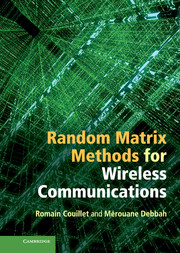Book contents
- Frontmatter
- Contents
- Preface
- Acknowledgments
- Acronyms
- Notation
- 1 Introduction
- Part I Theoretical aspects
- Part II Applications to wireless communications
- 11 Introduction to applications in telecommunications
- 12 System performance of CDMA technologies
- 13 Performance of multiple antenna systems
- 14 Rate performance in multiple access and broadcast channels
- 15 Performance of multi-cellular and relay networks
- 16 Detection
- 17 Estimation
- 18 System modeling
- 19 Perspectives
- 20 Conclusion
- References
- Index
11 - Introduction to applications in telecommunications
from Part II - Applications to wireless communications
Published online by Cambridge University Press: 07 October 2011
- Frontmatter
- Contents
- Preface
- Acknowledgments
- Acronyms
- Notation
- 1 Introduction
- Part I Theoretical aspects
- Part II Applications to wireless communications
- 11 Introduction to applications in telecommunications
- 12 System performance of CDMA technologies
- 13 Performance of multiple antenna systems
- 14 Rate performance in multiple access and broadcast channels
- 15 Performance of multi-cellular and relay networks
- 16 Detection
- 17 Estimation
- 18 System modeling
- 19 Perspectives
- 20 Conclusion
- References
- Index
Summary
In the preface of [Bai and Silverstein, 2009], Silverstein and Bai provide a table of the number of scientific publications in the domain of random matrix theory for ten-year periods. The table reveals that the number of publications roughly doubled from one period to the next, with an impressive total of more than twelve hundred publications for the 1995-2004 period. This trend is partly due to the mathematical tools developed over the years that allow for more and more possibilities for matrix model analysis. The major reason though is related to the increasing complexity of the system models employed in many fields of physics which demand low complexity analysis. We have already mentioned in the introductory chapter that nuclear physics, biology, finance, and telecommunications are among the fields in which the system complexity involved in the daily work of engineers is growing at a rapid pace. The second part of this book is entirely devoted to wireless communications and to some related signal processing topics. The reader must nonetheless be aware that many models developed here can be adapted to other fields of research, the typical example of such models being the sample covariance matrix model.
In the following section, we provide a brief historical account of the publications in wireless communications dealing with random matrices (from both small and large dimensional viewpoints), from the earlier results in ideal transmission channels down to recent refined examples reflecting more realistic communication environments.
- Type
- Chapter
- Information
- Random Matrix Methods for Wireless Communications , pp. 251 - 262Publisher: Cambridge University PressPrint publication year: 2011



